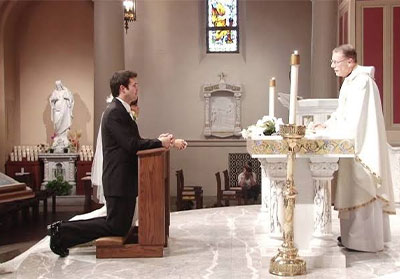
Having your wedding during Mass is known as a Nuptial Mass ceremony. Of all the different variations in which a Catholic couple could be married, the Nuptial Mass is the oldest and most formal form of ceremony available to all Catholics. For wedding ceremonies outside of Mass, please have a read of our article on Catholic Wedding Traditions.
Contents
What is a Nuptial Mass Wedding Ceremony?
A Nuptial Mass wedding ceremony is not the same sort of wedding ceremony that we often see on tv, in magazines, or in movies. What we see there, are non-Mass Catholic or Christian weddings.
You’ll know a Nuptial Mass wedding ceremony when you see one. This is because the bride and groom are seen at the front of the church, with their backs to their guests, either kneeling or sitting before the priest and the altar. They may have their witnesses or parents seated beside them, but you will not see a full bridal party accompanying them like you do during a non-Mass wedding ceremony.
A Nuptial Mass wedding ceremony has been structured around the readings from Scripture and the celebration of the Eucharist. This can make a Nuptial Mass wedding very restrictive in what can or can not be included as part of the wedding ceremony.
From the type of music that can be deemed suitable, to the very customs and traditions that the bride and groom are allowed to perform. Every aspect of the ceremony has been predefined as according to Scripture.
The main customization options available to the bride and groom, have a lot to do with the Scripture readings and the Psalms and Hymns that are sung by the guests. Under the guidance of the priest, the bride and groom can choose which Scripture, Psalms, and Hymns, may be included in their ceremony.
The priest will advise them on the suitability of each of their choices, and which sections of the Scripture needs to be read by himself, and which ones can be read by the bride and groom’s important guests.
Cultural or Social Customs
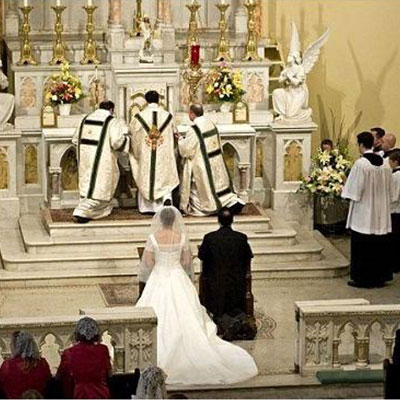
While a Nuptial Mass wedding ceremony can be rather limiting in its customization options, this isn’t to say that the bride and groom are expected to follow such a strick ceremony procedure, that additional customs must be ignored.
The clothing they wear, how they are seated before the priest, and whether or not they are allowed to share a nuptial veil (a Lazo) or use a Lasso; are all customs that the Church and/or priest are allowed to make allowances for.
Never assume anything when it comes to social or cultural customs though. Discuss them with your priest first. They may give you a flat out no, or they could say that there will be no complications with including these particular customs, or that they may require a compromise to be made.
For example, the lighting of a unity candle or the pouring of sand into a vase, may not be considered suitable enough for you to be able to incorporate them into the ceremony. Yet the priest may permit the lighting of the candle to be done prior to the commencement of the ceremony, with the candle being kept somewhere to the side.
Wedding Rehearsals Are Important
It is very important that wedding rehearsals are conducted prior to the wedding. There are several different ways for the ceremony to commence, and some customs may or may not be incorporated into the proceedings. For this reason, it is vital that everyone who is going to be participating in the ceremony, to know their role, and when and how this will be performed.
How are the bride and groom required to enter? How will the priest commence the Nuptial Mass? When will the guests be leading the assembly in the reading of Scriptures, or the singing of Psalms, and Hymns? When and how will additional customs and traditions be included during the ceremony?
All of this and more, need to be discussed and rehearsed prior to the big day to help ensure a smooth-running wedding.
What Are the Nuptial Mass Wedding Ceremony Procedures?
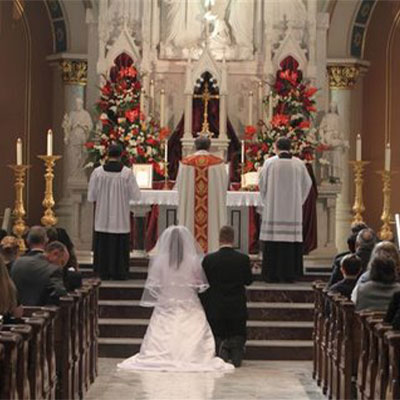
Before the ceremony can begin the bride and groom will need to take their place at the front of the church before the altar. The first few pews will be reserved for members of the bride and groom’s wedding party, their parents, and other important guests.
Most Nuptial Mass weddings are held when two practicing Catholics wish to be married. A Nuptial Wedding can be more of an open event when compared to that of the more private non-Mass wedding ceremony. At many of these ceremonies, all members of the parish are welcomed to attend the wedding, even if they do not know the bride or groom on a personal level.
The Wedding Ceremony
Unlike a non-Mass wedding, there is no “Here comes the bride” song that is played to indicate the bride’s arrival. The bride and groom may be seated in their required position before their guests are permitted entrance to the church. They may wait at the entrance, while they wait for everyone to take their seats before both the bride and groom can make their way down the aisle.
They may be escorted down one at a time by their parents, or they could escort each other down, hand in hand as they take their position. Once the bride and groom are seated, they will remain seated for the entirety of the ceremony.
1) The Gathering Rite
Also known as The Entrance Rite, all guests stand and wait for the ceremony to commence. When the priest is able to hold everyone’s attention, they begin by addressing everyone in attendance.
- The priest begins welcoming the guests, and family members of the bride and groom, along with any other members of the parish that may be attending.
- The purpose and significance of the ceremony is made clear to everyone, including the bride and groom.
- The first hymn of the ceremony is sung by the whole assembly.
- The priest will now invite everyone to join them in the opening prayer, before encouraging them to be seated.
2) The Liturgy of the Word
The priest will now lead the congregation in the readings from Scripture. What the priest reads aloud, may have been selected by the bride and groom, or by himself.
The First Reading
The priest will read Scripture from the Old Testament. At the conclusion of the reading, the priest proclaims “The word of the Lord” and those in attendance, respond with “Thanks be to God”.
Responsorial Psalm
If a choir is present, they will now lead the assembly in singing a psalm.
The Second Reading
The priest can read Scripture from a book of the New Testament. At the conclusion of the reading, the priest proclaims “The word of the Lord” and those in attendance, respond with “Thanks be to God”.
Gospel Acclamation
Everyone in attendance stands and sings the Gospel Acclamation. There are several options available for the hymn that is sung. Outside of Lent, the Alleluia is the more common choice for most weddings.
The Reading of the Gospel
The priest will now readout of the Gospel for all to hear. At the conclusion of the reading, the priest proclaims “The Gospel of the Lord” and those in attendance, respond with “Praise to you, Lord Jesus Christ”, before taking their seats again.
Homily
The priest will offer their spiritual insight on matters of life, love, union, or the graces of the Lord, that relate to this particular wedding ceremony, or couple. While the inspiration of a Homily is drawn the Scripture readings themselves, a Homily is more of an educational sermon, rather than spiritual directions or instructions.
3) The Celebration of Matrimony
Now comes the part where the priest will focus all of their attention on the bride and groom themselves. To let everyone in attendance know that they are now going to be addressing the bride and groom directly, the priest will inform the assembly of this by saying something along the lines of:
“Dearly beloved, you have come together into the house of the Church so that in the presence of the Church’s minister and the community, your intention to enter into Marriage may be strengthened by the Lord with a sacred seal. Christ abundantly blesses the love that binds you. Through a special Sacrament, he enriches and strengthens those he has already consecrated by Holy Baptism, that they may; be faithful to each other forever and assume all the responsibilities of married life. And so, in the presence of the Church, I ask you to state your intentions.”
Confirmation of Intent
The priest questions the bride and groom to confirm that they truly wish to be married, are freely choosing to do so out of their own free will, and that they’ll agree upon the terms and conditions that come with being married.
“(Bride) and (Groom), have you come here to enter into Marriage without coercion, freely and wholeheartedly?”
Bride and Groom: “I have”
“Are you prepared, as you follow the path of Marriage, to love and to honor each other for as long as you both shall live?”
Bride and groom: “I am”
*“Are you prepared to accept children lovingly from God and to bring them up according to the law of Christ and his Church?”
Bride and Groom: “I am”
*The question pertaining to children may be omitted if the bride and groom are getting on in age. It can also be passed if the couple is aware that one of them may have fertility complications.
Consent
The final act of consent to the marriage is shown when the priest invites them to declare their consent:
“Since it is your intention to enter the covenant of Holy Matrimony, join your right hands, and declare your consent before God and his Church.”
The Bride and Groom will now join their right hands.
Wedding Vows
There are several different ways in which the wedding vows can be exchanged. The priest may ask the bride and groom of their intentions, they may recite the vows to each other, or they may even use vows that they have written themselves. Here are some examples of what may be said:
Priest to the Groom:
“(Groom’s name), do you take (the Bride’s name) for your lawful wedded wife, to have and to hold, from this day forward, for better, for worse, for richer, for poorer, in sickness and in health, until death do you part?”
The Groom: “I do.”
Priest to the Bride:
“(Bride’s name), do you take (Groom’s name) for your lawful wedded husband, to have and to hold, from this day forward, for better, for worse, for richer, for poorer, in sickness and in health, until death do you part?”
The Bride: “I do.”
Groom to the Bride:
“I, (their name), take you, (the Bride’s name), for my lawful wife, to have and to hold, from this day forward, for better, for worse, for richer, for poorer, in sickness and in health, until death do us part.”
Bride to the Groom:
“I, (their name), take you, (the Groom’s name), for my lawful husband, to have and to hold, from this day forward, for better, for worse, for richer, for poorer, in sickness and in health, until death do us part.”
Written Their Own Vows:
“(Their partner’s name) ever since we first met (how they met), I knew that I wanted to spend the rest of my life with you, to grow old together, and start a family. I have been the one who (the effect that they have had on their lives, or the things that they love about them). I would be honored if you were to accept me as your lawful wedded (Husband/Wife).”
The Reception of Consent
Following the exchanging of vows, the priest will say something along the line of:
“May the Lord in his kindness strengthen the consent you have declared before the Church and graciously bring to fulfillment his blessings within you. What God has joined, let no one put asunder.
May the God of Abraham, the God of Isaac, the God of Jacob, the God who joined together our first parents in paradise, strength and bless in Christ the consent you have declared before the Church, so that what God joins together, no one may put asunder.”
Before inviting those in attendance to praise god:
“Let us bless the Lord.”
Those in assembly:
“Thanks be to God.”
The Blessing and Giving of the Rings
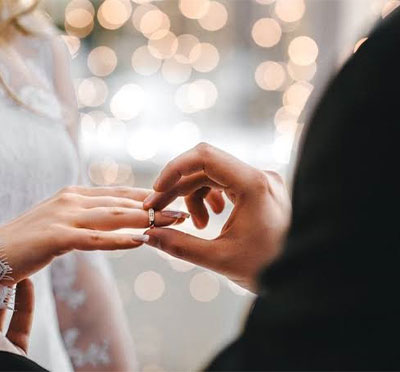
Before the rings are given over to the bride and groom, the priest will have them blessed by reciting a prayer similar to the following prayer:
Bless, O Lord, these rings
which we bless in your name.
so that those who wear them
may remain entirely faithful to each other,
abide in peace and in your will,
and live always in mutual charity.
Through Christ our Lord.Amen.
The priest might sprinkle the rings with holy water, before giving the first ring to the groom. The groom places the ring on his bride’s ring finger, and may say:
“(the Bride’s name), receive this ring as a sign of my love and fidelity. In the name of the Father, and of the Son, and of the Holy Spirit.”
The priest then hands the bride the other ring. The bride places the ring on her groom’s ring finger, repeating the same:
“(the Groom’s name), receive this ring as a sign of my love and fidelity. In the name of the Father, and of the Son, and of the Holy Spirit.”
4) Liturgy of the Eucharist
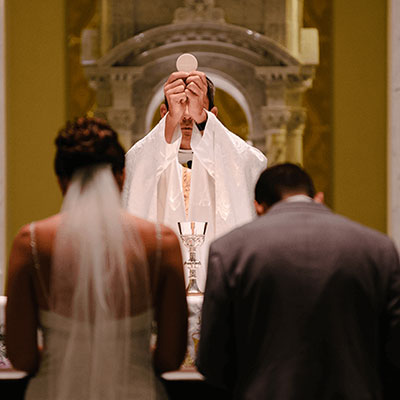
The liturgy of the Eucharist, or Holy Communion as it is also known, is prepared for by the priests and his assisting ministers, page boy, or ring bearer. As the altar is prepared and the gifts of bread and wine, body and blood, are brought forth; the assembly sits and sings the Offertory Song.
Eucharistic Prayer
When the priest is prepared, he will recite:
Priest:
“Pray, brothers and sisters, that my sacrifice and yours may be acceptable to God, the almighty Father”
“Blessed are you, Lord God of all creation, for, through your goodness, we have received the bread we offer you: fruit of the earth and work of human hands, it will become for us the bread of life.”
Everyone in attendance:
“Blessed be God forever.”
Priest:
“By the mystery of this water and wine may we come to share in the divinity of Christ who humbled himself to share in our humanity.”
“Blessed are you, Lord God of all creation, for, through your goodness, we have received the wine we offer you: fruit of the vine and work of human hands, it will become our spiritual drink.”
Everyone in attendance:
“Blessed be God forever.”
“With humble spirit and contrite heart may we be accepted by you, O Lord, and may our sacrifice in your sight this day be pleasing to you, Lord God.”
Priest:
“Pray, brothers and sisters, that my sacrifice and yours may be acceptable to God, the almighty Father.”
Everyone in attendance stands:
“May the Lord accept the sacrifice at your hands for the praise and glory of his name, for our good and the good of all his holy Church.”
5) Communion Rite
Who will be receiving communion is one of the things that need to be discussed with the priest during rehearsals. Communion may only be for the bride and groom, or the priest may permit important guests, or everyone in assembly to receive their communion. But what about your non-Christian guests? Can they receive communion, or must they stand aside?
The Lord’s Prayer
The Lord’s Prayer (the Our Father) is prayed aloud or in silence. In some churches, the Lord’s Prayer may even be sung by all who are in attendance.
Nuptial Blessing
The couple may approach the altar where they’ll kneel before the priest, or the priest will stand before them himself. The priest will then invite the assembly to join each other in silent prayer for the couple. Extending his hands over the bride and groom, he offers them the nuptial blessing. If a culturally appropriate Lazo or Lasso are used during the ceremony, they will now be applied to the bride and groom.
Sign of Peace
The sign of peace is a deeply symbolic gesture of love, forgiveness, and acceptance of one another.
The Priest will recite:
“Peace of the Lord be with you”
Everyone in attendance:
“And with you”
Priest:
“Let us give on another a sign of peace”
Everyone, including the bride and groom, will now exchange a sign of peace. This could be a simple handshake, a light peck on the cheek, a hug, or a friendly wave, to those who are near them. The way also repeat the words:
“Peace be with you”
Lamb of God
Everyone in attendance will now kneel as the priest breaks bread, which represents the host. Together, the assembly will begin to sing the “Lamb of God.”
Communion
The priest presents the Body and Blood of Christ to the bride and groom. If more people are to receive their communion, the assembly sings psalms or hymns that are appropriate for the occasion, as the recipients revive their communion.
6) Concluding Rite
With the rings exchanged, and their vows sworn to one another, the bride and groom can now be declared, “Husband and Wife”.
Blessing
The priest will now recite a solemn blessing over the newly married couple, their families and friends, and anyone else who may be present. Everyone present will participate in the blessing by repeatedly interjecting with an “Amen” in unison with one another.
Witnesses may be called to sign the marriage license in front of the assembly. This may be done to the side of the church, or in front of the altar, but never upon it.
Dismissal
The assembly will be dismissed by the priest, who will offer a humble blessing of:
“Go in peace to glorify the Lord with your life.”
Everyone in attendance: “Thanks be to God.”
Recessional
With the license signed, the priest may seal the deal by saying:
“I now pronounce you, Husband and Wife, you may kiss the bride”
Thus concluding the wedding ceremony, as the newlyweds lead everyone out of the church. The couple is followed by their bridal party, the ministers, and the priest who conducted their wedding ceremony. The parents of the couple may also make their way outside before anyone else.
As the wedding progression makes their way out, there may be hymns sung by the choir, or festive and celebratory music may accompany them.
Wedding Reception
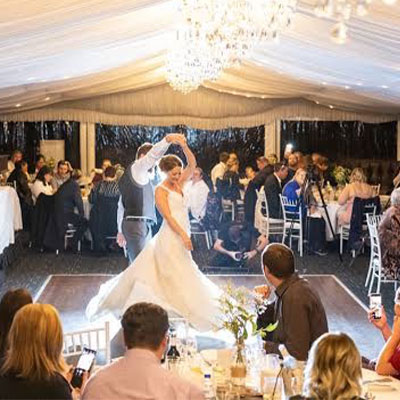
With the wedding ceremony over, the newlyweds may pose for photos, thank their guests, or pay their respects to their parents and grandparents. Most western cultures conclude the day with a wedding reception.
This is an event where the close friends and family of the couple, will gather for a party in celebration of the occasion. There can be a lot of food, alcohol, and music and dancing at this event.
It’s a time for everyone to let their hair down, share stories with one another, and show their love and appreciation for the happy couple. The wedding reception is where we can see far more of the cultural differences that can be found in Catholics from all over the world.
Share this moment with your loved ones and enjoy yourself. You can be playful with your husband or wife when cutting the cake, you can spend the evening with friends and family that you don’t get to see that often. And it’s where you can have your first dance together as husband and wife.
Leave a Reply